fuel consumption FIAT IDEA 2010 1.G Owners Manual
[x] Cancel search | Manufacturer: FIAT, Model Year: 2010, Model line: IDEA, Model: FIAT IDEA 2010 1.GPages: 210, PDF Size: 4.4 MB
Page 30 of 210
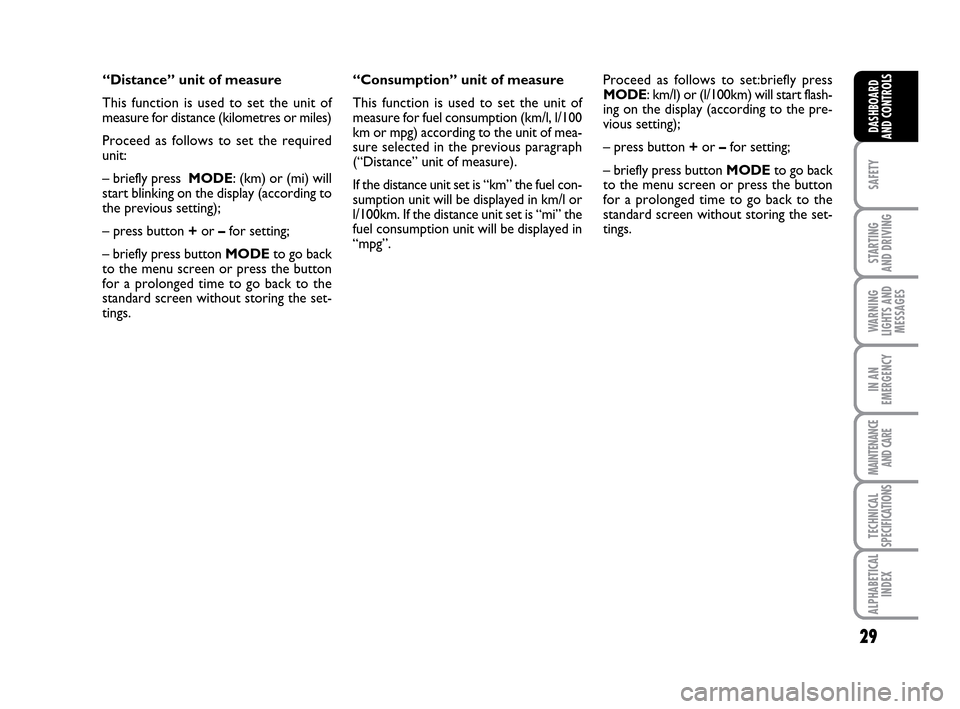
29
SAFETY
STARTING
AND DRIVING
WARNING
LIGHTS AND
MESSAGES
IN AN
EMERGENCY
MAINTENANCE
AND CARE
TECHNICAL
SPECIFICATIONS
ALPHABETICAL
INDEX
DASHBOARD
AND CONTROLS
“Distance” unit of measure
This function is used to set the unit of
measure for distance (kilometres or miles)
Proceed as follows to set the required
unit:
– briefly press MODE: (km) or (mi) will
start blinking on the display (according to
the previous setting);
– press button +or –for setting;
– briefly press button MODEto go back
to the menu screen or press the button
for a prolonged time to go back to the
standard screen without storing the set-
tings.Proceed as follows to set:briefly press
MODE: km/l) or (l/100km) will start flash-
ing on the display (according to the pre-
vious setting);
– press button +or –for setting;
– briefly press button MODEto go back
to the menu screen or press the button
for a prolonged time to go back to the
standard screen without storing the set-
tings. “Consumption” unit of measure
This function is used to set the unit of
measure for fuel consumption (km/l, l/100
km or mpg) according to the unit of mea-
sure selected in the previous paragraph
(“Distance” unit of measure).
If the distance unit set is “km” the fuel con-
sumption unit will be displayed in km/l or
l/100km. If the distance unit set is “mi” the
fuel consumption unit will be displayed in
“mpg”.
001-035 LUM IDEA GB 2 ed.qxd 19-01-2010 9:14 Pagina 29
Page 35 of 210
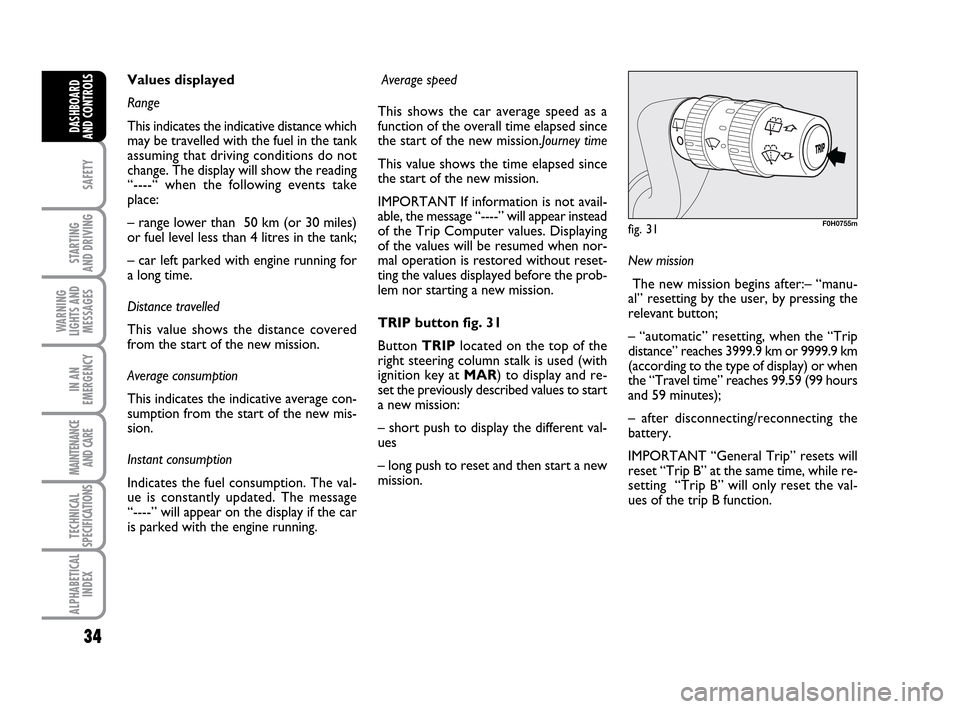
34
SAFETY
STARTING
AND DRIVING
WARNING
LIGHTS AND
MESSAGES
IN AN
EMERGENCY
MAINTENANCE
AND CARE
TECHNICAL
SPECIFICATIONS
ALPHABETICAL
INDEX
DASHBOARD
AND CONTROLS
New mission
The new mission begins after:– “manu-
al” resetting by the user, by pressing the
relevant button;
– “automatic” resetting, when the “Trip
distance” reaches 3999.9 km or 9999.9 km
(according to the type of display) or when
the “Travel time” reaches 99.59 (99 hours
and 59 minutes);
– after disconnecting/reconnecting the
battery.
IMPORTANT “General Trip” resets will
reset “Trip B” at the same time, while re-
setting “Trip B” will only reset the val-
ues of the trip B function. Average speed
This shows the car average speed as a
function of the overall time elapsed since
the start of the new mission.Journey time
This value shows the time elapsed since
the start of the new mission.
IMPORTANT If information is not avail-
able, the message “----” will appear instead
of the Trip Computer values. Displaying
of the values will be resumed when nor-
mal operation is restored without reset-
ting the values displayed before the prob-
lem nor starting a new mission.
TRIP button fig. 31
Button TRIPlocated on the top of the
right steering column stalk is used (with
ignition key at MAR) to display and re-
set the previously described values to start
a new mission:
– short push to display the different val-
ues
– long push to reset and then start a new
mission. Values displayed
Range
This indicates the indicative distance which
may be travelled with the fuel in the tank
assuming that driving conditions do not
change. The display will show the reading
“----“ when the following events take
place:
– range lower than 50 km (or 30 miles)
or fuel level less than 4 litres in the tank;
– car left parked with engine running for
a long time.
Distance travelled
This value shows the distance covered
from the start of the new mission.
Average consumption
This indicates the indicative average con-
sumption from the start of the new mis-
sion.
Instant consumption
Indicates the fuel consumption. The val-
ue is constantly updated. The message
“----” will appear on the display if the car
is parked with the engine running.
fig. 31F0H0755m
001-035 LUM IDEA GB 2 ed.qxd 19-01-2010 9:14 Pagina 34
Page 117 of 210
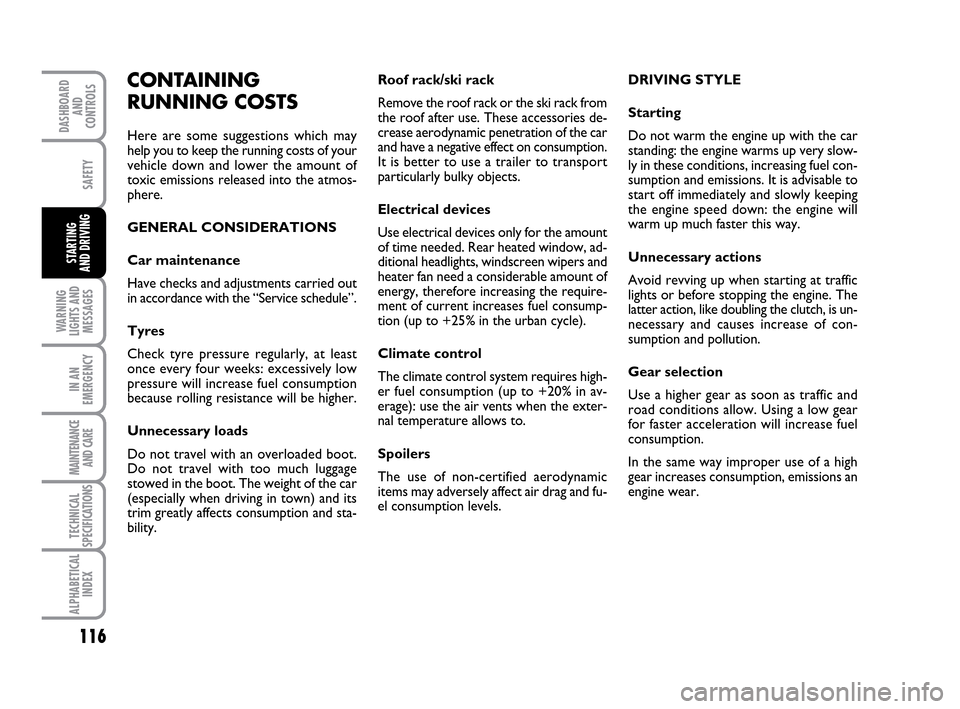
116
WARNING
LIGHTS AND
MESSAGES
IN AN
EMERGENCY
MAINTENANCE
AND CARE
TECHNICAL
SPECIFICATIONS
ALPHABETICAL
INDEX
DASHBOARD
AND
CONTROLS
SAFETY
STARTING
AND DRIVING
CONTAINING
RUNNING COSTS
Here are some suggestions which may
help you to keep the running costs of your
vehicle down and lower the amount of
toxic emissions released into the atmos-
phere.
GENERAL CONSIDERATIONS
Car maintenance
Have checks and adjustments carried out
in accordance with the “Service schedule”.
Tyres
Check tyre pressure regularly, at least
once every four weeks: excessively low
pressure will increase fuel consumption
because rolling resistance will be higher.
Unnecessary loads
Do not travel with an overloaded boot.
Do not travel with too much luggage
stowed in the boot. The weight of the car
(especially when driving in town) and its
trim greatly affects consumption and sta-
bility.Roof rack/ski rack
Remove the roof rack or the ski rack from
the roof after use. These accessories de-
crease aerodynamic penetration of the car
and have a negative effect on consumption.
It is better to use a trailer to transport
particularly bulky objects.
Electrical devices
Use electrical devices only for the amount
of time needed. Rear heated window, ad-
ditional headlights, windscreen wipers and
heater fan need a considerable amount of
energy, therefore increasing the require-
ment of current increases fuel consump-
tion (up to +25% in the urban cycle).
Climate control
The climate control system requires high-
er fuel consumption (up to +20% in av-
erage): use the air vents when the exter-
nal temperature allows to.
Spoilers
The use of non-certified aerodynamic
items may adversely affect air drag and fu-
el consumption levels.DRIVING STYLE
Starting
Do not warm the engine up with the car
standing: the engine warms up very slow-
ly in these conditions, increasing fuel con-
sumption and emissions. It is advisable to
start off immediately and slowly keeping
the engine speed down: the engine will
warm up much faster this way.
Unnecessary actions
Avoid revving up when starting at traffic
lights or before stopping the engine. The
latter action, like doubling the clutch, is un-
necessary and causes increase of con-
sumption and pollution.
Gear selection
Use a higher gear as soon as traffic and
road conditions allow. Using a low gear
for faster acceleration will increase fuel
consumption.
In the same way improper use of a high
gear increases consumption, emissions an
engine wear.
111-122 LUM IDEA GB 2 ed.qxd 14-01-2010 12:32 Pagina 116
Page 118 of 210
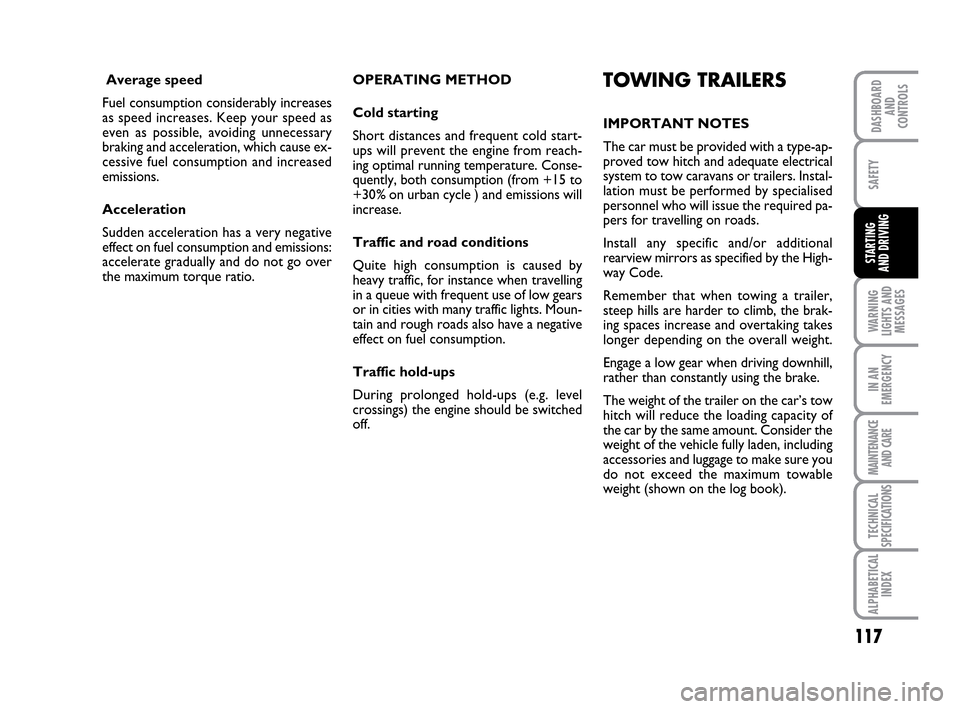
117
WARNING
LIGHTS AND
MESSAGES
IN AN
EMERGENCY
MAINTENANCE
AND CARE
TECHNICAL
SPECIFICATIONS
ALPHABETICAL
INDEX
DASHBOARD
AND
CONTROLS
SAFETY
STARTING
AND DRIVING
Average speed
Fuel consumption considerably increases
as speed increases. Keep your speed as
even as possible, avoiding unnecessary
braking and acceleration, which cause ex-
cessive fuel consumption and increased
emissions.
Acceleration
Sudden acceleration has a very negative
effect on fuel consumption and emissions:
accelerate gradually and do not go over
the maximum torque ratio.OPERATING METHOD
Cold starting
Short distances and frequent cold start-
ups will prevent the engine from reach-
ing optimal running temperature. Conse-
quently, both consumption (from +15 to
+30% on urban cycle ) and emissions will
increase.
Traffic and road conditions
Quite high consumption is caused by
heavy traffic, for instance when travelling
in a queue with frequent use of low gears
or in cities with many traffic lights. Moun-
tain and rough roads also have a negative
effect on fuel consumption.
Traffic hold-ups
During prolonged hold-ups (e.g. level
crossings) the engine should be switched
off.TOWING TRAILERS
IMPORTANT NOTES
The car must be provided with a type-ap-
proved tow hitch and adequate electrical
system to tow caravans or trailers. Instal-
lation must be performed by specialised
personnel who will issue the required pa-
pers for travelling on roads.
Install any specific and/or additional
rearview mirrors as specified by the High-
way Code.
Remember that when towing a trailer,
steep hills are harder to climb, the brak-
ing spaces increase and overtaking takes
longer depending on the overall weight.
Engage a low gear when driving downhill,
rather than constantly using the brake.
The weight of the trailer on the car’s tow
hitch will reduce the loading capacity of
the car by the same amount. Consider the
weight of the vehicle fully laden, including
accessories and luggage to make sure you
do not exceed the maximum towable
weight (shown on the log book).
111-122 LUM IDEA GB 2 ed.qxd 14-01-2010 12:32 Pagina 117
Page 182 of 210
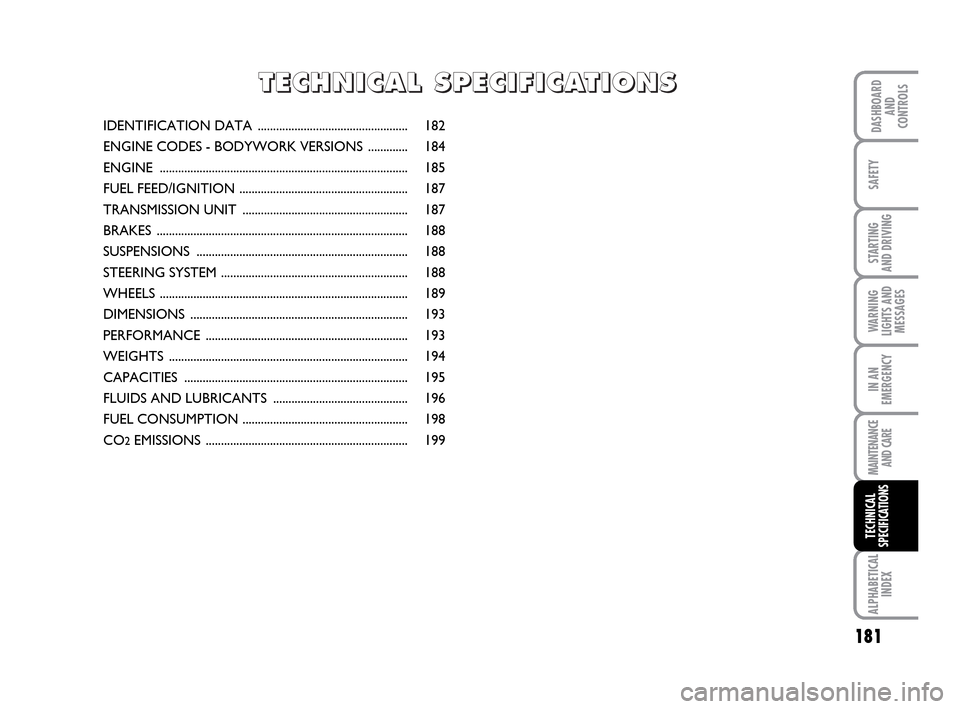
181
STARTING
AND DRIVING
IN AN
EMERGENCY
MAINTENANCE
AND CARE
ALPHABETICAL
INDEX
DASHBOARD
AND
CONTROLS
SAFETY
WARNING
LIGHTS AND
MESSAGES
TECHNICAL
SPECIFICATIONS
IDENTIFICATION DATA ................................................. 182
ENGINE CODES - BODYWORK VERSIONS ............. 184
ENGINE ................................................................................. 185
FUEL FEED/IGNITION ....................................................... 187
TRANSMISSION UNIT ...................................................... 187
BRAKES .................................................................................. 188
SUSPENSIONS ..................................................................... 188
STEERING SYSTEM ............................................................. 188
WHEELS ................................................................................. 189
DIMENSIONS ....................................................................... 193
PERFORMANCE .................................................................. 193
WEIGHTS .............................................................................. 194
CAPACITIES ......................................................................... 195
FLUIDS AND LUBRICANTS ............................................ 196
FUEL CONSUMPTION ...................................................... 198
CO
2EMISSIONS .................................................................. 199
T T
E E
C C
H H
N N
I I
C C
A A
L L
S S
P P
E E
C C
I I
F F
I I
C C
A A
T T
I I
O O
N N
S S
181-199 LUM IDEA GB 2 ed.qxd 14-01-2010 13:56 Pagina 181
Page 199 of 210
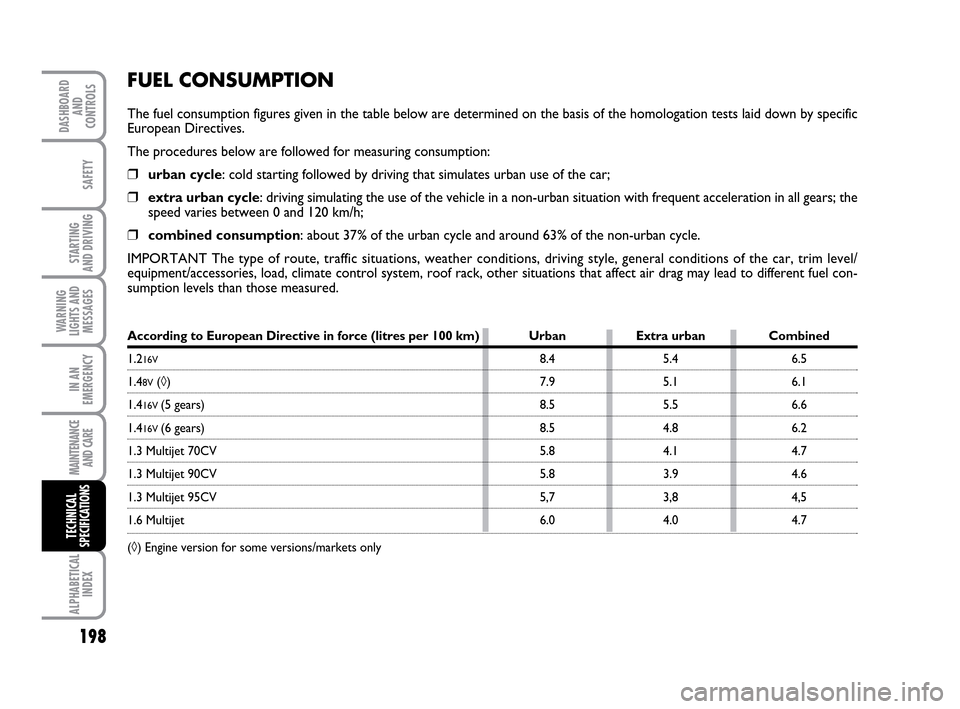
198
STARTING
AND DRIVING
IN AN
EMERGENCY
MAINTENANCE
AND CARE
ALPHABETICAL
INDEX
DASHBOARD
AND
CONTROLS
SAFETY
WARNING
LIGHTS AND
MESSAGES
TECHNICAL
SPECIFICATIONS
FUEL CONSUMPTION
The fuel consumption figures given in the table below are determined on the basis of the homologation tests laid down by specific
European Directives.
The procedures below are followed for measuring consumption:
❒urban cycle: cold starting followed by driving that simulates urban use of the car;
❒extra urban cycle: driving simulating the use of the vehicle in a non-urban situation with frequent acceleration in all gears; the
speed varies between 0 and 120 km/h;
❒combined consumption: about 37% of the urban cycle and around 63% of the non-urban cycle.
IMPORTANT The type of route, traffic situations, weather conditions, driving style, general conditions of the car, trim level/
equipment/accessories, load, climate control system, roof rack, other situations that affect air drag may lead to different fuel con-
sumption levels than those measured.
According to European Directive in force (litres per 100 km) Urban Extra urban Combined
1.216V8.4 5.4 6.5
1.48V(◊) 7.9 5.1 6.1
1.416V (5 gears) 8.5 5.5 6.6
1.416V (6 gears) 8.5 4.8 6.2
1.3 Multijet 70CV 5.8 4.1 4.7
1.3 Multijet 90CV 5.8 3.9 4.6
1.3 Multijet 95CV 5,7 3,8 4,5
1.6 Multijet 6.0 4.0 4.7
(◊) Engine version for some versions/markets only
181-199 LUM IDEA GB 2 ed.qxd 14-01-2010 13:56 Pagina 198
Page 200 of 210
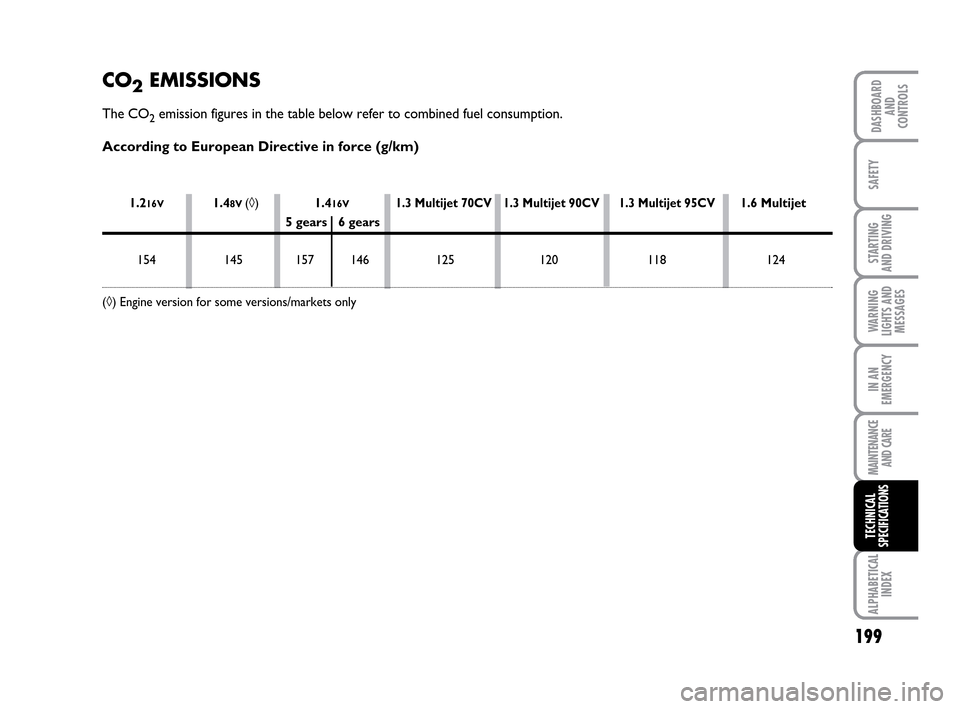
199
STARTING
AND DRIVING
IN AN
EMERGENCY
MAINTENANCE
AND CARE
ALPHABETICAL
INDEX
DASHBOARD
AND
CONTROLS
SAFETY
WARNING
LIGHTS AND
MESSAGES
TECHNICAL
SPECIFICATIONS
CO2EMISSIONS
The CO2emission figures in the table below refer to combined fuel consumption.
According to European Directive in force (g/km)
1.216V1.48V (◊)1.416V1.3 Multijet 70CV 1.3 Multijet 90CV 1.3 Multijet 95CV1.6 Multijet
5 gears 6 gears
154 145 157 146 125 120 118 124
(◊) Engine version for some versions/markets only
181-199 LUM IDEA GB 2 ed.qxd 14-01-2010 13:56 Pagina 199
Page 202 of 210

201
STARTING
AND DRIVING
IN AN
EMERGENCY
MAINTENANCE
AND CARE
DASHBOARD
AND
CONTROLS
SAFETY
WARNING
LIGHTS AND
MESSAGES
TECHNICAL
SPECIFICATIONS
ALPHABETICAL
INDEX
Dipped beam headlights
- bulb replacement .................. 148
- controls .................................... 58
Direction indicators .................... 59
Direction indicators
- bulb replacement .................. 148
- controls .................................... 59
Door pockets ................................ 69
Doors
- emergency device for
opening the doors from
the outside ........................ 17-134
Dualdrive
(electric power steering) ......... 87
EBD
(electronic brake distributor) ... 83
Emergency device for opening
the doors from the outside ..... 134
Engine compartment ......... 167-168
Engine coolant gauge .................. 19
Engine cooling system fluid level 170
Engine oil consumption .............. 169Engine oil level .............................. 169
Engine oil
- level check ............................... 169
- technical specifications .......... 195
Engine
- cranking ........................... 18-112
- features ..................................... 185
- identification code ................ 184
- power supply ............................ 187
Environment protection.............. 92
EOBD (system) ............................ 84
Exterior lights ............................... 58
Fiat CODE (The system) .......... 9
Fix&GO (quick tyre repair kit) . 136
Flashing the headlights ................ 58
Fluids and lubricants .................... 196
Fog lights
- bulb replacement .................. 149
- control buttons ....................... 66
Follow me home (device) ........... 59FPS (Fire Protection System) .... 67
Front air bags ................................. 106
- driver's front airbag................. 106
- front airbag passenger side.... 107
- manual deactivation of front
and side passenger airbags ... 108
Fuel cap .......................................... 91
Fuel consumption ........................ 116
Fuel savings..................................... 116
Fuel
- consumption ............................. 116
- fuel gauge .................................. 19
- inertia fuel switch ................... 67
Fuses ............................................... 153
Gearbox (use) ............................ 115
GSI system...................................... 84
Hazard warning lights
- controls .................................... 66
Head restraints ............................ 41
Headlamp alignment corrector 82
200-208 LUM IDEA GB 2 ed.qxd 14-01-2010 13:59 Pagina 201